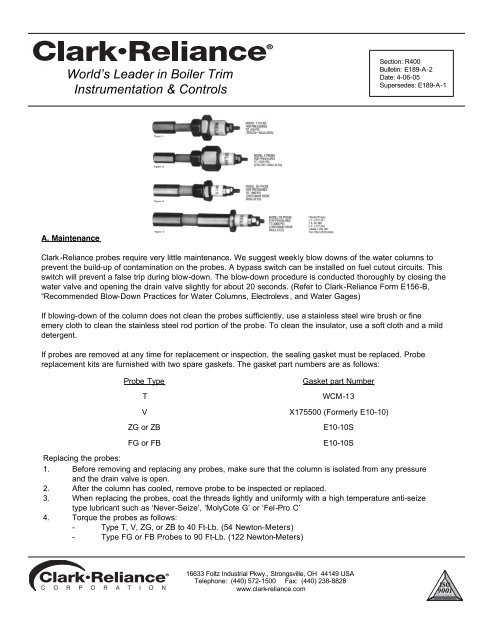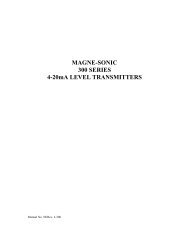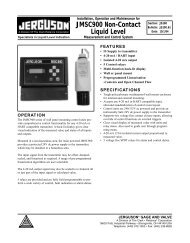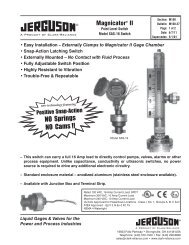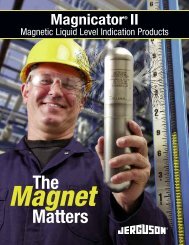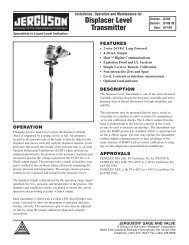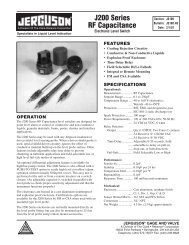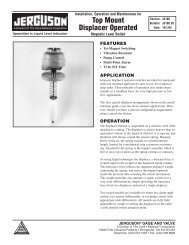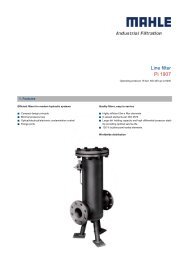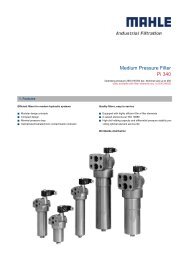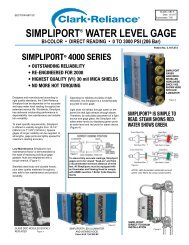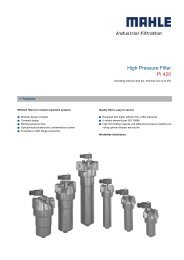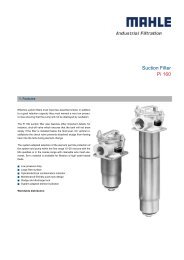E189-A-2 Probes.pdf - Clark Reliance
E189-A-2 Probes.pdf - Clark Reliance
E189-A-2 Probes.pdf - Clark Reliance
You also want an ePaper? Increase the reach of your titles
YUMPU automatically turns print PDFs into web optimized ePapers that Google loves.
World’s Leader in Boiler TrimInstrumentation & ControlsSection: R400Bulletin: <strong>E189</strong>-A-2Date: 4-06-05Supersedes: <strong>E189</strong>-A-1A. Maintenance<strong>Clark</strong> -<strong>Reliance</strong> probes require very little maintenance. We suggest weekly blow downs of the water columns toprevent the build-up of contamination on the probes. A bypass switch can be installed on fuel cutout circuits. Thisswitch will prevent a false trip during blow-down. The blow-down procedure is conducted thoroughly by closing thewater valve and opening the drain valve slightly for about 20 seconds. (Refer to <strong>Clark</strong>-<strong>Reliance</strong> Form E156-B,“Recommended Blow-Down Practices for Water Columns, Electrolevs , and Water Gages)If blowing-down of the column does not clean the probes sufficiently, use a stainless steel wire brush or fineemery cloth to clean the stainless steel rod portion of the probe. To clean the insulator, use a soft cloth and a milddetergent.If probes are removed at any time for replacement or inspection, the sealing gasket must be replaced. Probereplacement kits are furnished with two spare gaskets. The gasket part numbers are as follows:Probe TypeTVZG or ZBGasket part NumberWCM-13X175500 (Formerly E10-10)E10-10SFG or FBE10-10SReplacing the probes:1. Before removing and replacing any probes, make sure that the column is isolated from any pressureand the drain valve is open.2. After the column has cooled, remove probe to be inspected or replaced.3. When replacing the probes, coat the threads lightly and uniformly with a high temperature anti-seizetype lubricant such as ‘Never-Seize’, ‘MolyCote G’ or ‘Fel-Pro C’4. Torque the probes as follows:- Type T, V, ZG, or ZB to 40 Ft-Lb. (54 Newton-Meters)- Type FG or FB <strong>Probes</strong> to 90 Ft-Lb. (122 Newton-Meters)16633 Foltz Industrial Pkwy., Strongsville, OH 44149 USATelephone: (440) 572-1500 Fax: (440) 238-882816633 Foltz Industrial Pkwy., www.clark-reliance.comStrongsville, OH 44149 USATelephone: (440) 572-1500 Fax: (440) 238-8828www.clark-reliance.com
Hot torquing is suggested for all probes. However, the column must be isolated from service with the drain valve openbefore re-torquing the probes.The hot torquing procedure will extend probe sealing gasket life and should be performedas follows:1. Partially open steam valve to warm up the column with the drain valve slightly open.2. Close steam (and water) valves to isolate the column.3. Open the drain valve completely.4. Re-torque as instructed above.5. Return to service by closing the drain valve and opening the steam and water valves.B. InterwiringThe wires attached to the probes must be of high temperature type in order to withstand the heat. <strong>Clark</strong>-<strong>Reliance</strong>suggests the following types of wire:Maximum ApplicationPressure (PSI)10001001 to 3000WireSpecification18 Ga. Stranded conductors, Teflon insulation rated at300 VAC and 200ºC(Belden #83029, Alpha #5857, or equal)18 Ga. Stranded conductors, Teflon treated glassbraided insulation rated at 300 VAC and 400ºC, Nickelcoated copper conductor U.L #5182(Radix #MGT-4502 or equal)The high temperature wires attached to the probes can be routed to a local junction box or directly to the control unit. Ifa junction box is used, a low cost 18 Ga. Multi-conductor cable may be used to carry the signal to the control unit. Wesuggest Belden #8467 or equal.Note: When installing the high temperature wire to the probe, use an open end wrench to prevent theProbe assembly from turning while tightening the wire terminal nut. Use a ¼” wrench for both thecompression nut and the terminal nuts on T and V type probes. ZG, ZB, FG, and FB type probes require a ½”wrench for the compression nut and a 3/8” wrench for the terminal nut.C. TroubleshootingTroubleshooting is only necessary in the event that a control relay fails to energize or de-energize. In the event that therelay fails to de-energize during blow-down, the cause is a failed (short circuited) probe. The probe should be replaced.In the event that a relay fails to energize, the following steps should be taken:1. Verify probe wiring to the appropriate probes from each relay.2. Verify water level in the column.3. Exchange relays to verify function. If the problem moves with the relay, then replace the relay.Any additional questions should be directed to your local <strong>Clark</strong>-<strong>Reliance</strong> Representative, or to the Factory.Phone: (440) 572-1500 Fax: (440) 238-8828“Always use only genuine <strong>Clark</strong>-<strong>Reliance</strong> replacement parts!”
"PARTS-PLUS"Critical spare parts for overnightdelivery, direct from the manufacturer.clark-reliance.com/partsSteel Valve Repair KitReplacement <strong>Probes</strong> Gage Glass Repair Kit Simpliport ModuleSimpliport Packing Nut Replacement Relays Probe Repair Kit Replacement EA100 Ass’yReplacement Micro-switch Bronze Valve Repair Kit Valve Packing Replacement Floats16633 Foltz Parkway Strongsville, OH 44149 USAPhone (440) 572-1500 Fax (440) 238-8828sales@clark-reliance.com www.clark-reliance.com


